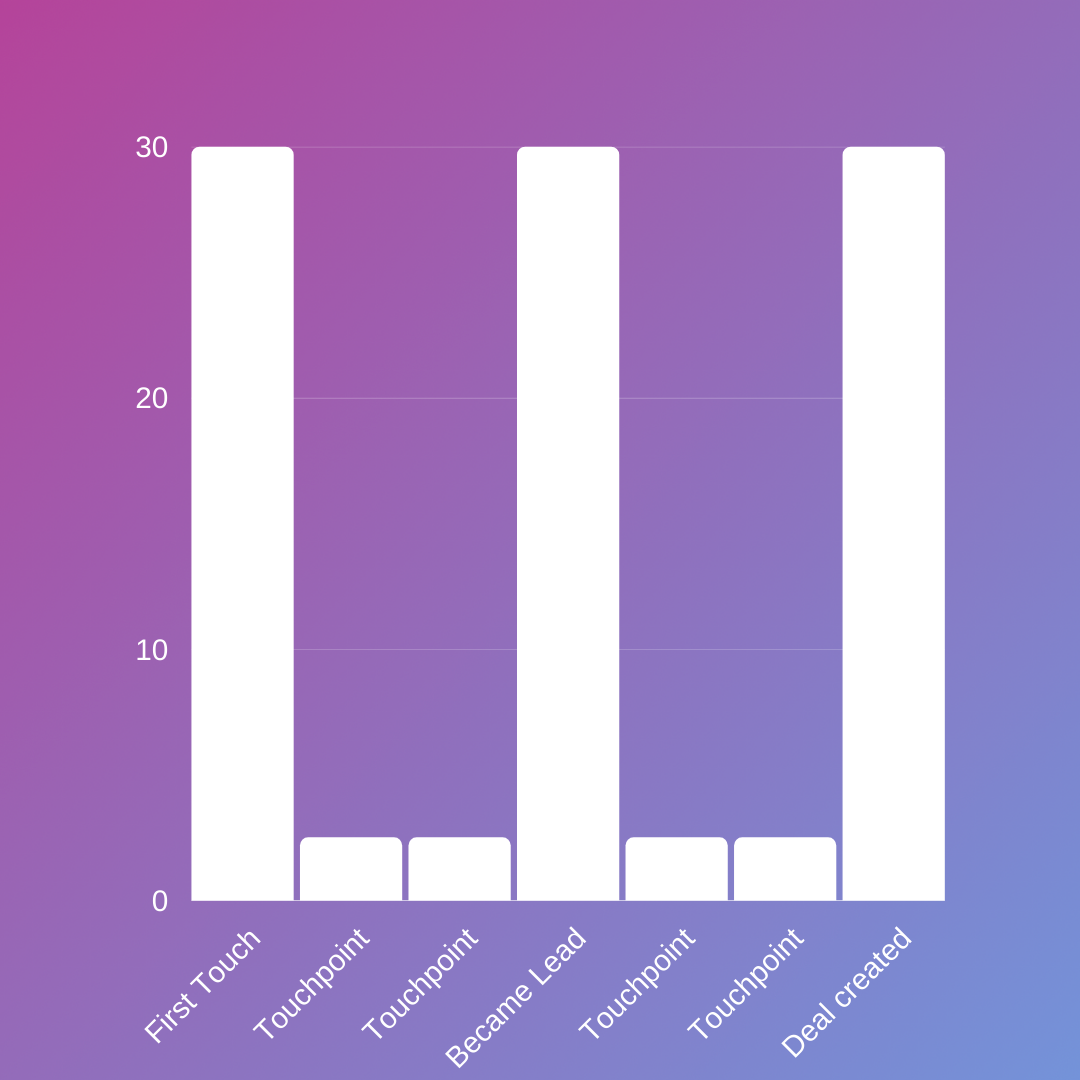Marketing attribution, revenue attribution, attribution reporting - whatever you call it, here's how to understand the different models and how to use it.
What is marketing attribution?
First up, let's get the definitions out of the way. Marketing attribution, sometimes called revenue attribution, is simply the method of working out which marketing tactics are contributing to your conversions and/or sales.
In longer terms, it is the method of evaluating which marketing touchpoints are involved in a customer journey that leads to a successful conversion. It's identifying the actions or events that contribute, in some way, to your desired outcome.
Let's use an example.
Susan is our prospect. She finds our website through a post on social media. She reads a blog post. She also looks at a few website pages, and then she signs up for our newsletter. Later, after reading a couple of our emails, she clicks a CTA and fills in her contact info, speaks to us, and becomes a client, spending £1,000.
There are multiple touchpoints in this journey:
- Social media
- Blog post
- Website pages
- Newsletter signup
- CTA
- Sales conversation
What marketing attribution does is assign a proportion of the revenue generated from Susan's conversion across those different touchpoints.
When you have this kind of reporting across all of your deals, it becomes much easier to see which of your channels are generating the most revenue - either directly, or by contributing to the customer journey.
Attribution Models
There are multiple different ways of attributing revenue across the touchpoints in your buyer's journey and they all give slightly different (and occasionally wildly different) results. So, let's take a look at the different models and when/why you might use them.
First Touch Attribution
This model gives all of the credit for the conversion to the first interaction between you and your prospect. In Susan's case, all credit would go to social media, because that's the first place she interacted with us. So, social media would be marked responsible for 100% of the £1,000 from Susan.
This model is useful for identifying where people first discover your business, or are first prompted to engage with you, but beyond that it can be pretty limited. It doesn't recognise that all of the other content that Susan looked at might have had a big influence on her decision to purchase. But it's helpful for contact creation reports.
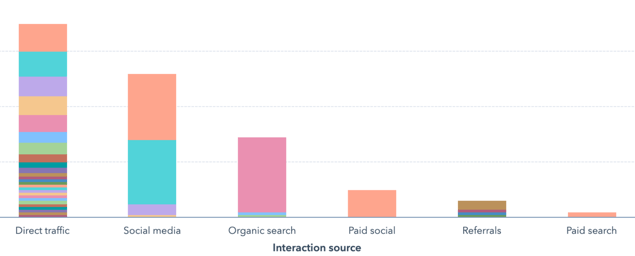
Last Touch Attribution
This is the model that essentially tells you what pushed someone over the edge into buying from you. What was the last thing they interacted with before signing a deal? Like First Touch, Last Touch is a single point attribution and only takes into account one touchpoint, ignoring all other interaction.
It's useful if you want to see what finally caused people to become clients. We don't tend to like this report because it ignores everything else - and while First Touch also ignores everything else, it gives us a hint as to how our marketing is doing. You're most likely to find Last Touch on PPC reporting.
Linear Attribution
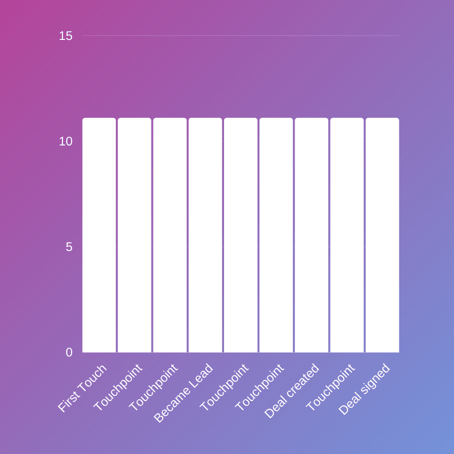
In this model, every interaction between the prospect and your marketing and sales process is given equal weight. So, the 7 touchpoints Susan experienced would get an equal share of Susan's £1,000, or £142.87 each.
Linear attribution is a useful baseline, especially when you're first starting with Attribution reporting, and it gives you a picture of how your prospects interact with all of your assets. But it doesn't weight anything as more or less important.
U-Shaped Attribution
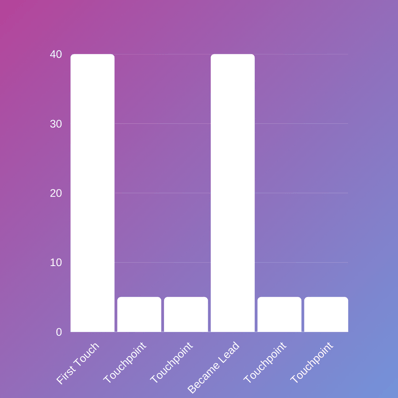
This model is more focused on the top half of the funnel, recognising that some actions are worth more than others. So, it allocates the majority of the revenue to the first touch, and the first point that the prospect becomes a lead - each of these actions get 40% of the revenue credit, with the remaining 20% shared equally between the actions that happen between these two points.
In Susan's case, the social media post gets 40% of the credit, the page she was on when she signed up to the newsletter gets 40%, and the blog post and other website pages get 20% between them.
This is a good way to see what content/touchpoints contribute to getting leads that are closing.
W-Shaped Attribution
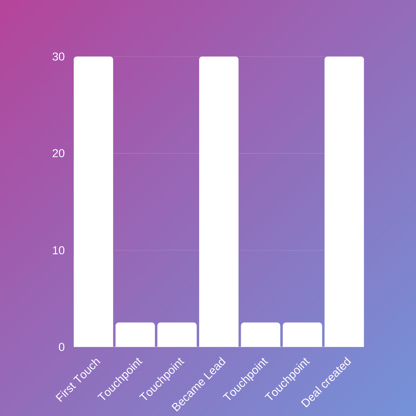
W-shaped takes things a step further than U-shaped, and brings an element of the later parts of the funnel - deal/opportunity creation.
30% of the credit goes to first touch, 30% to lead creation, and another 30% to the action that leads to the prospect becoming an opportunity (or a deal being created). The remaining 10% is split equally among the actions that take place between these stages.
Back to Susan - social media is assigned £300, newsletter page gets £300, and the CTA gets £300, with £25 each going to blog, email, website page, and conversation.
Full Path Attribution
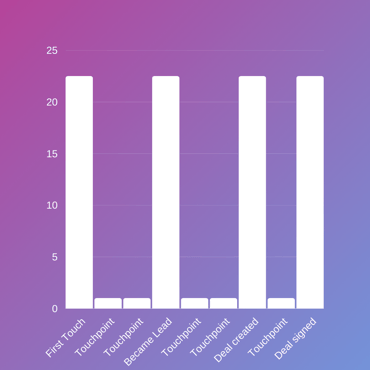
Finally, full path attribution assigns 22.5% of the credit to each of the 4 major touchpoints - first touch, lead created, deal created, last interaction before deal signed - and the remaining 10% between the actions between these points.
Full path takes into account sales and marketing activity, and gives a broader picture of your customer journey and funnel.
For Susan's deal, £225 each is assigned to social media, newsletter page, CTA, and sales conversation, with everything else sharing the final £100.
Attribution Reporting Questions
If someone in sales starts and closes a deal, then surely they get all the credit for it?
This is a common thought, but it doesn't take into account any of the touchpoints outside of the salesperson that the prospect might have experienced.
Even if the lead came from prospecting or other sales activity, the lead might have gone to your website to learn more about your company before deciding whether or not to respond to that outreach email. The website plays a part in the deal, because without it, that lead might not have progressed.
The lead might not have intended to respond at all, but then saw a social post or ad, clicked on it, and became interested enough to get in touch after all. Attribution reporting recognises that there are multiple ways that our leads interact with us, and that those all contribute to the overall sale.
How can we pick up on all these touchpoints?
Excellent question. Attribution across every marketing touchpoint is difficult - many say it's impossible to get a full and complete view of everything.
One of the things that makes it much more accurate and effective is having a system that is fully integrated - it's why we use HubSpot (more on that later). If you have to go into 3, 4, or 5 different systems to find out how all of your marketing is performing, it's incredibly difficult to tie up how your prospects have interacted with you, especially if your CRM isn't integrated with each of these systems.
Look at it this way - someone clicks on a Google Ad. They visit your website. They're signed up to your email marketing and click on some links in your latest email. They read a blog post. They view a landing page. They liked one of your tweets. How can you identify all of those touchpoints against a specific person, and see where they were in the customer journey at the time of the interaction? You need a system (like HubSpot) that tracks everything in one place.
Which attribution model should we use?
With so many different models, it can be tough to decide which will be the most effective. Ultimately, it depends on your business, and what you want to track. You can use all of the models, but you need to compare like against like. If you look at them all side by side, you'll see there can be some pretty significant differences between them:

If you just want to look at your marketing, U-Shaped is likely to be your best choice. If you want to include sales, W-Shaped or Full Path. If you just want to know where things come from, without worrying about how everything else contributed, First Touch is your answer. And if you're still not sure, Linear is a decent starting point.
All of the models are valid and contain useful information, though multi-touch attribution almost always gives a more complete picture (that's everything other than First or Last Touch).
Attribution Models in Action
As HubSpot Partners, you won't be surprised to learn that we use HubSpot's Attribution Reporting - we have a whole dashboard created for this specific type of reporting, in fact.
We have all the different types of reports represented, because they're all useful for different things, but there are a few that are worth mentioning. We look at the data weekly, monthly, and quarterly, depending on things like KPIs, activity levels, and meeting frequency.
Our Main Report
This is the one that gets reported on in Senior Management Meetings (the other models are more useful to individual teams). For this, we use Full Path Attribution and look at the quarter to date. One of the useful things about HubSpot dashboards is being able to quickly filter all reports to a specific time period, so if we want to look at this week, month, quarter, or a rolling date range like last 90 days
We can see revenue attributed to sales, organic search, direct traffic, email marketing, and social media. It's always interesting to see how each has contributed overall - social media had a much bigger impact than we originally expected, but on diving deeper into the data, we can see that a lot of that impact comes from the CEO's LinkedIn feed, rather than our business accounts (hence writing the CEO's guide to using LinkedIn to support marketing!)
Where Leads Come From
So, there are plenty of reports that show where leads come from, without using attribution reporting. However, if we use an attribution model for this, it helps us not only see where they're coming from, but which sources are the most valuable. And that helps us focus our time and energy on the most effective lead sources - the ones that deliver closed deals, rather than only those that create contacts/leads.
For this, we use a First Touch Attribution Model, because we want to know where the person first interacted with us before becoming a lead, prospect, or customer. Then we can look at the value attributed to those touchpoints.
Content Types
This report shows us which types of content have created the most revenue - across meetings, calls, emails, web pages, landing pages, and social posts.

For our marketing team, this is super helpful - we can see exactly what types of content are generating revenue, and therefore put more into focusing on those. But that's step one, step two is our next report...
Marketing Content Attribution
This breaks things down even further than the report above, and shows us exactly which pieces of content are generating revenue - from specific landing and page pages, to specific emails. We can see that our AltNet Virtual Networking page leads the pack in our Year to Date view, while our Customer Communications webinar is leading for this quarter. And we can see that some of our content - like a newsletter from February - has an impact much after it initially went out.

Using HubSpot for Attribution
As we mentioned in the Questions section of this post, one of the hardest things with attribution reporting is being able to actually, effectively attribute touchpoints to your eventual deals.
Which is why we decided to use HubSpot in the first place. The benefit is that, once someone is in your database, you can see what they've interacted with, how they've engaged with your marketing, what web pages they've looked at, what emails they've received and clicked, and what social posts they've interacted with.
Oh, and we can log meetings and calls, as well as individual emails (in addition to the marketing emails), so activity from our sales team is also there for attribution.
Because of cookies, someone's activity prior to finding their way onto our database (through filling in a form or signing up to something) can also be attributed to them - that's how we can know what the first touch is, as well as what happened to make them into a contact.
Of course, nothing is perfect, and there's always a margin for error - if someone clears cookies between their first touch and becoming a contact, that data will be lost, for example. So, it's not completely foolproof. But, compared to trying to track down data from separate systems - social, email, landing pages, PPC, analytics, sales calls, etc. - it's still a whole a lot more accurate.
If you do use lots of separate systems, some of them will have some level of attribution - Google Ads, for example. But that's only one piece of the puzzle, and if you want reporting that takes into account your whole sales and marketing journey, you need an integrated system.
In the interests of impartiality, there are other integrated systems that have attribution reporting - Zoho has lead attribution reports, Marketo has revenue attribution reporting, ActiveCampaign has some attribution reports, and so on. The key to all of them is that they're fully integrated - they store your contact database and provide marketing software. That's what you need for useful attribution.
Tips for Using Attribution Models
- Whichever model you choose, the key is to be consistent. If you decide to use U-Shaped Attribution because the numbers look great this month, you shouldn't switch to W-Shaped next month because the balance changed.
We may look at all the different reports - because they all give us different information and insights - but our main metric (the one we report on) uses one of the models, and sticks to the same one every month, no matter which looks better. This way, we can accurately follow trends over time, track our marketing ROI, identify our most effective content, and evaluate our whole process. - If you use multiple models, it's worth documenting which are used for which specific purposes - for example your ROI report always uses Full Path, but your snapshot reporting uses Linear. Without documenting, it's very easy for different numbers to be substituted next time around.
- Create a cheat sheet for which model does what. Having the figures to hand makes it easier for people to identify what each of your models or reports is showing them, and why it uses that particular split of revenue as its attribution.
- If you've never used Attribution Reporting before, test and measure. Instead of choosing one report and going with that, look at all of them for a few months.
- If your business changes, your attribution model might need to change, too. Yes, we did just say that you need to be consistent, but there are times when a change is genuinely necessary (rather than being ad hoc). You might have introduced a new sales team, or added a new process, or built up better alignment between your sales and marketing teams. All of these might result in you needing to focus on a different model - for example moving from U-Shaped to W-Shaped to bring in more of the sales process.
If you're not sure whether you have the right data to be able to truly assess your marketing and sales functions, we can help.

